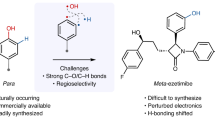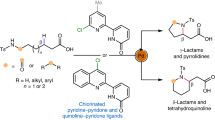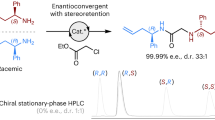Abstract
Boron dipyrromethenes (BODIPYs) are a class of tetracoordinate boron compounds that have attracted considerable interest in recent decades due to their excellent spectroscopic properties and structural versatility, leading to their widespread applications in chemical, biological, pharmaceutical and materials science. However, BODIPYs possessing boron-stereogenic centres in enantioenriched forms are rare and catalytic methodology to enantioselectively prepare a boron-stereogenic BODIPY remains elusive. Here we report a palladium-catalysed protocol for the enantioselective synthesis of boron-stereogenic BODIPYs via a desymmetric intramolecular C–H arylation reaction. This method gives access to a wide range of highly functionalized boron-stereogenic BODIPYs, including six- to nine-membered boron heterocycles, with good to excellent enantioselectivities. The discrimination of the two α C–H bonds of the BODIPY core is enabled by the co-action of steric hindrance and attractive interaction in the catalytic chiral pocket. Photophysical properties, derivatizations and applications in chiral recognition of the obtained chiroptical BODIPYs are investigated. This work enriches the chemical diversity of chiroptical BODIPY dyes.

This is a preview of subscription content, access via your institution
Access options
Subscribe to this journal
Receive 12 digital issues and online access to articles
$119.00 per year
only $9.92 per issue
Buy this article
- Purchase on Springer Link
- Instant access to full article PDF
Prices may be subject to local taxes which are calculated during checkout



Similar content being viewed by others
Data availability
The data that support the findings of this study are available within the paper and its Supplementary Information files. Raw data are also available from the corresponding author on reasonable request. Materials and methods, experimental procedures, characterization data, 1H, 13C, 19F, 11B NMR spectra and mass spectrometry data are available in the Supplementary Information. The X-ray crystallographic coordinates for structures reported in this study have been deposited at the Cambridge Crystallographic Data Centre (CCDC), under deposition number CCDC 2175350 (2w). These data can be obtained free of charge from the CCDC via www.ccdc.cam.ac.uk/data_request/cif.
References
Pop, F., Zigon, N. & Avarvari, N. Main-group-based electro- and photoactive chiral materials. Chem. Rev. 119, 8435–8478 (2019).
Loudet, A. & Burgess, K. BODIPY dyes and their derivatives: syntheses and spectroscopic properties. Chem. Rev. 107, 4891–4932 (2007).
Ulrich, G., Ziessel, R. & Harriman, A. The chemistry of fluorescent BODIPY dyes: versatility unsurpassed. Angew. Chem. Int. Ed. 47, 1184–1201 (2008).
Boens, N., Leen, V. & Dehaen, W. Fluorescent indicators based on BODIPY. Chem. Soc. Rev. 41, 1130–1172 (2012).
Kamkaew, A. et al. BODIPY dyes in photodynamic therapy. Chem. Soc. Rev. 42, 77–88 (2013).
Kolemen, S. & Akkaya, E. U. Reaction-based BODIPY probes for selective bio-imaging. Coord. Chem. Rev. 354, 121–134 (2018).
Boens, N., Verbelen, B., Ortiz, M. J., Jiao, L. & Dehaen, W. Synthesis of BODIPY dyes through postfunctionalization of the boron dipyrromethene core. Coord. Chem. Rev. 399, 213024 (2019).
Poddar, M. & Misra, R. Recent advances of BODIPY based derivatives for optoelectronic applications. Coord. Chem. Rev. 421, 213462 (2020).
Lu, H., Mack, J., Nyokong, T., Kobayashi, N. & Shen, Z. Optically active BODIPYs. Coord. Chem. Rev. 318, 1–15 (2016).
Sanchez-Carnerero, E. M. et al. Circularly polarized luminescence by visible-light absorption in a chiral O-BODIPY dye: unprecedented design of CPL organic molecules from achiral chromophores. J. Am. Chem. Soc. 136, 3346–3349 (2014).
Alnoman, R. B. et al. Circularly polarized luminescence from helically chiral N,N,O,O-boron-chelated dipyrromethenes. Chemistry 22, 93–96 (2016).
Saikawa, M., Nakamura, T., Uchida, J., Yamamura, M. & Nabeshima, T. Synthesis of figure-of-eight helical bisBODIPY macrocycles and their chiroptical properties. Chem. Commun. 52, 10727–10730 (2016).
Wu, Y., Wang, S., Li, Z., Shen, Z. & Lu, H. Chiral binaphthyl-linked BODIPY analogues: synthesis and spectroscopic properties. J. Mater. Chem. C 4, 4668–4674 (2016).
Clarke, R. et al. Circularly polarised luminescence from helically chiral ‘confused’ N,N,O,C-boron-chelated dipyrromethenes (BODIPYs). ChemPhotoChem 1, 513–517 (2017).
Guerrero-Corella, A. et al. BODIPY as electron withdrawing group for the activation of double bonds in asymmetric cycloaddition reactions. Chem. Sci. 10, 4346–4351 (2019).
Maeda, C., Nagahata, K., Shirakawa, T. & Ema, T. Azahelicene-fused BODIPY analogues showing circularly polarized luminescence. Angew. Chem. Int. Ed. 59, 7813–7817 (2020).
Rigotti, T. et al. Boron dipyrromethene (BODIPY) as electron-withdrawing group in asymmetric copper-catalyzed [3 + 2] cycloadditions for the synthesis of pyrrolidine-based biological sensors. Adv. Synth. Catal. 362, 1345–1355 (2020).
Meazza, M. et al. Studying the reactivity of alkyl substituted BODIPYs: first enantioselective addition of BODIPY to MBH carbonates. Chem. Sci. 12, 4503–4508 (2021).
Docekal, V. et al. Stereoselective cyclopropanation of boron dipyrromethene (BODIPY) derivatives by an organocascade reaction. Adv. Synth. Catal. 364, 930–937 (2022).
Haefele, A., Zedde, C., Retailleau, P., Ulrich, G. & Ziessel, R. Boron asymmetry in a BODIPY derivative. Org. Lett. 12, 1672–1675 (2010).
Gobo, Y., Matsuoka, R., Chiba, Y., Nakamura, T. & Nabeshima, T. Synthesis and chiroptical properties of phenanthrene-fused N2O-type BODIPYs. Tetrahedron Lett. 59, 4149–4152 (2018).
Vedejs, E. et al. Asymmetric memory at labile, stereogenic boron: enolate alkylation of oxazaborolidinones. J. Am. Chem. Soc. 121, 2460–2470 (1999).
Charoy, L. et al. Synthesis of benzylcyanoborane adducts of amines and separation of their enantiomers; SN2 substitution at boron atom. Chem. Commun. 2275–2276 (2000).
Imamoto, T. & Morishita, H. An enantiomerically pure tetracoordinate boron compound: stereochemistry of substitution reactions at the chirogenic boron atom. J. Am. Chem. Soc. 122, 6329–6330 (2000).
Toyota, S., Ito, F., Nitta, N. & Hakamata, T. Substituent effects on configurational stabilities at tetrahedral boron atoms in intramolecular borane–amine complexes: structures, enantiomeric resolution, and rates of enantiomerization of [2-(dimethylaminomethyl)phenyl]phenylboranes.Bull. Bull. Chem. Soc. Jpn. 77, 2081–2088 (2004).
Braun, M., Schlecht, S., Engelmann, M., Frank, W. & Grimme, S. Boron-based diastereomerism and enantiomerism in imine complexes—determination of the absolute configuration at boron by CD spectroscopy. Eur. J. Org. Chem. 2008, 5221–5225 (2008).
Kaiser, P. F., White, J. M. & Hutton, C. A. Enantioselective preparation of a stable boronate complex stereogenic only at boron. J. Am. Chem. Soc. 130, 16450–16451 (2008).
Schlecht, S., Frank, W. & Braun, M. Stereogenic boron in 2-amino-1,1-diphenylethanol-based boronate–imine and amine complexes. Beilstein J. Org. Chem. 7, 615–621 (2011).
Jimenez, V. G. et al. Circularly polarized luminescence of boronic acid-derived salicylidenehydrazone complexes containing chiral boron as stereogenic unit. J. Org. Chem. 83, 14057–14062 (2018).
Aupic, C. et al. Highly diastereoselective preparation of chiral NHC-boranes stereogenic at the boron atom. Chem. Sci. 10, 6524–6530 (2019).
Zu, B., Guo, Y. & He, C. Catalytic enantioselective construction of chiroptical boron-stereogenic compounds. J. Am. Chem. Soc. 143, 16302–16310 (2021).
Zhang, G. et al. Construction of boron-stereogenic compounds via enantioselective Cu-catalyzed desymmetric B–H bond insertion reaction. Nat. Commun. 13, 2624 (2022).
Courtis, A. M. et al. Monoalkoxy BODIPYs—a fluorophore class for bioimaging. Bioconjugate Chem. 25, 1043–1051 (2014).
Umeda, N. et al. Boron dipyrromethene as a fluorescent caging group for single-photon uncaging with long-wavelength visible light. ACS Chem. Biol. 9, 2242–2246 (2014).
Sharma, A. K. et al. Visible-light-triggered uncaging of carbonyl sulfide for hydrogen sulfide (H2S) release. Org. Lett. 19, 4822–4825 (2017).
Lu, H., Mack, J., Yang, Y. & Shen, Z. Structural modification strategies for the rational design of red/NIR region BODIPYs. Chem. Soc. Rev. 43, 4778–4823 (2014).
Ikeda, C., Maruyama, T. & Nabeshima, T. Convenient and highly efficient synthesis of boron-dipyrrins bearing an arylboronate center. Tetrahedron Lett. 50, 3349–3351 (2009).
Chen, N. et al. Sterically protected N2O-type benzopyrromethene boron complexes from boronic acids with intense red/near-infrared fluorescence. Org. Lett. 19, 2026–2029 (2017).
Liu, Y. et al. Synthesis of N,O,B-chelated dipyrromethenes through an unexpected intramolecular cyclisation: enhanced near-infrared emission in the aggregate/solid state. Chem. Eur. J. 24, 13549–13555 (2018).
Saget, T. & Cramer, N. Enantioselective C–H arylation strategy for functionalized dibenzazepinones with quaternary stereocenters. Angew. Chem. Int. Ed. 52, 7865–7868 (2013).
Lin, Z. Q., Wang, W. Z., Yan, S. B. & Duan, W. L. Palladium-catalyzed enantioselective C-H arylation for the synthesis of P-stereogenic compounds. Angew. Chem. Int. Ed. 54, 6265–6269 (2015).
Liu, L. et al. Asymmetric synthesis of P-stereogenic phosphinic amides via Pd(0)-catalyzed enantioselective intramolecular C–H arylation. Org. Lett. 17, 2046–2049 (2015).
Yang, L., Neuburger, M. & Baudoin, O. Chiral bifunctional phosphine-carboxylate ligands for palladium(0)-catalyzed enantioselective C–H arylation. Angew. Chem. Int. Ed. 57, 1394–1398 (2018).
Vyhivskyi, O., Kudashev, A., Miyakoshi, T. & Baudoin, O. Chiral catalysts for Pd(0)-catalyzed enantioselective C–H activation. Chem. Eur. J. 27, 1231–1257 (2021).
Falivene, L. et al. SambVca 2. A web tool for analyzing catalytic pockets with topographic steric maps. Organometallics 35, 2286–2293 (2016).
Falivene, L. et al. Towards the online computer-aided design of catalytic pockets. Nat. Chem. 11, 872–879 (2019).
Bickelhaupt, F. M. & Houk, K. N. Analyzing reaction rates with the distortion/interaction–activation strain model. Angew. Chem. Int. Ed. 56, 10070–10086 (2017).
Ess, D. H. & Houk, K. N. Theory of 1,3-dipolar cycloadditions: distortion/interaction and frontier molecular orbital models. J. Am. Chem. Soc. 130, 10187–10198 (2008).
Kowada, T., Maeda, H. & Kikuchi, K. BODIPY-based probes for the fluorescence imaging of biomolecules in living cells. Chem. Soc. Rev. 44, 4953–4972 (2015).
Pu, L. Simultaneous determination of concentration and enantiomeric composition in fluorescent sensing. Acc. Chem. Res. 50, 1032–1040 (2017).
Acknowledgements
We are grateful for financial support from the National Natural Science Foundation of China (22122102, 22101120, 22271134), the Guangdong Provincial Key Laboratory of Catalysis (2020B121201002), the Shenzhen Science and Technology Innovation Committee (JCYJ20190809142809370) and the Stable Support Plan Program of Shenzhen Natural Science Fund (contract number 20200925152450004).
Author information
Authors and Affiliations
Contributions
B.Z., Y.G. and C.H. conceived the project. B.Z., Y.G. and L.-Q.R. designed and performed the synthetic experiments. Y.L. designed and performed the computational studies. B.Z., Y.G., Y.L. and C.H. prepared the manuscript.
Corresponding authors
Ethics declarations
Competing interests
The authors declare no competing interests.
Peer review
Peer review information
Nature Synthesis thanks José Alemán, Hua Lu, Jolene Reid and the other, anonymous, reviewer(s) for their contribution to the peer review of this work. Primary handling editor: Peter Seavill, in collaboration with the Nature Synthesis team.
Additional information
Publisher’s note Springer Nature remains neutral with regard to jurisdictional claims in published maps and institutional affiliations.
Supplementary information
Supplementary Information
Experimental details, supplementary sections 1–16, figs. 1–15 and tables 1–7.
Supplementary Data 1
Crystallographic data for compound 2w, CCDC 2175350.
Source data
Source Data Fig. 1
Statistical source data.
Source Data Fig. 3
Statistical source data.
Rights and permissions
Springer Nature or its licensor (e.g. a society or other partner) holds exclusive rights to this article under a publishing agreement with the author(s) or other rightsholder(s); author self-archiving of the accepted manuscript version of this article is solely governed by the terms of such publishing agreement and applicable law.
About this article
Cite this article
Zu, B., Guo, Y., Ren, LQ. et al. Catalytic enantioselective synthesis of boron-stereogenic BODIPYs. Nat. Synth 2, 564–571 (2023). https://doi.org/10.1038/s44160-023-00262-1
Received:
Accepted:
Published:
Issue Date:
DOI: https://doi.org/10.1038/s44160-023-00262-1



